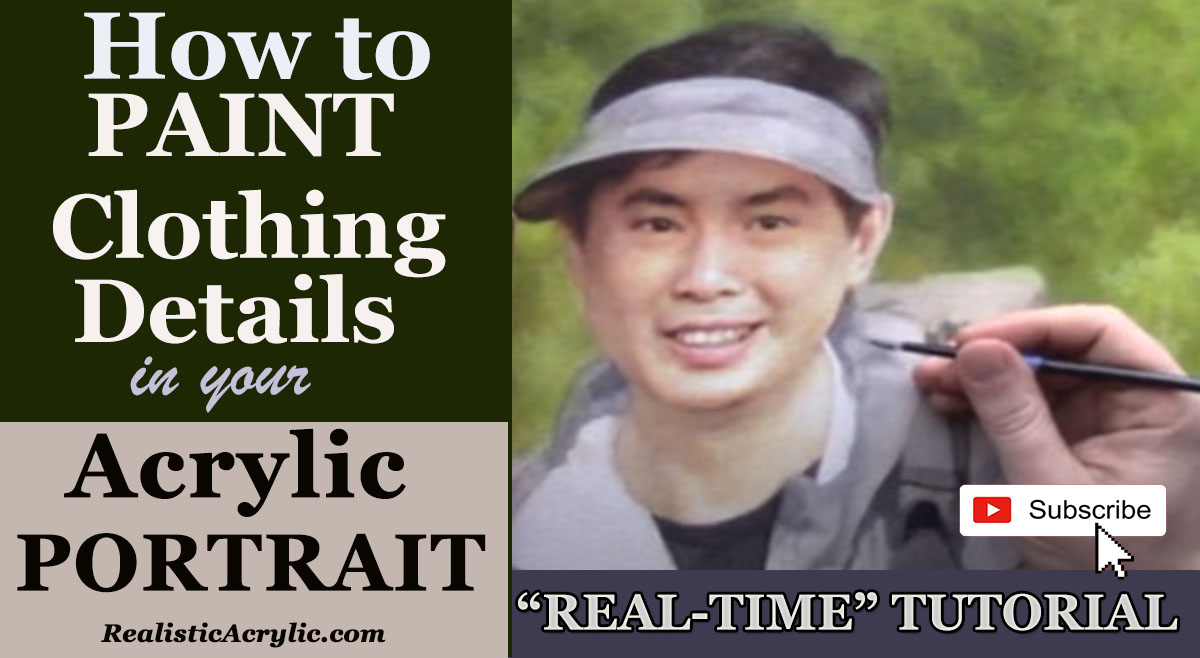- You are here:
- Home »
- Blog »
- Video Tutorial »
- How to Paint Clothing in Acrylic Portrait

How to Paint Clothing in Acrylic Portrait
Unleash your artistic potential: Learning clothing techniques for stunning acrylic portraits
Painting clothing in acrylic portraits is a vital skill that enhances the overall composition and realism of your artwork. Then the nuances of fabric texture and color play a crucial role in bringing your subject to life. In this post, essential techniques will be explored to help you master painting clothing in acrylic portraiture.
Materials Needed
To get started, a few key materials will be necessary:
- Acrylic Paints: Choose a variety of colors, including skin tones and fabric shades.
- Brushes: Flat and round brushes for different techniques.
- Palette: For mixing colors.
- Canvas or Board: Prepare your surface with gesso.
- Water: For cleaning brushes and thinning paint.
Color Mixing Techniques
So understanding the color wheel is fundamental in painting clothing. Once mixing primary colors, you can create a wide range of realistic fabric tones. And then a mixture of warm and cool colors will add depth and dimension to your palette.
Preparing the Canvas
Before you begin painting, it is essential to set up your workspace. So apply gesso to your canvas for better paint adhesion. Because this preparation creates a smooth surface that enhances the paint application process.
5. Layering Techniques
Layering is crucial in acrylic painting. Whereas it allows for the gradual buildup of colors and textures. Then start with a base layer, applying a diluted mixture of your main color. Allow it to dry before adding additional layers for shading and highlights.
6. Shadows and Highlights
While creating shadows and highlights will give your fabric depth and dimension. You also need to observe the light source in your reference photo to understand how it interacts with the clothing. And then use darker tones for shadows and lighter tones for highlights to enhance realism.
7. Capturing Texture and Details
Different fabrics require specific techniques to replicate their texture accurately. For instance, cotton may be smoother, while wool may require more brush strokes to convey its texture. And then close observation of reference photos is essential in capturing the intricacies of the clothing.
8. Practical Step-by-Step Process
- Step 1: Start by sketching the clothing outline on your canvas while you use light pencil marks to guide your paint application.
- Step 2: Apply the base layer using a large flat brush while you choose to a mid-tone color that represents the fabric.
- Step 3: Once the base layer dries, add shadows using a darker shade. Focus on areas where the fabric folds and overlaps to create depth.
- Step 4: Finish by adding highlights and detailing the fabric. Use a fine brush for intricate designs and texture work, ensuring the highlights are consistent with your light source.
9. Common Challenges and Solutions
It is common for artists to struggle with achieving realistic fabric textures. So I had a few tips for you to overcoming these challenges include:
- Practice regularly to build your confidence in observing and replicating fabric.
- Be patient with layering. It may take several layers to achieve the desired effect.
- Experiment with different brush techniques to find what works best for you.
Conclusion
Painting clothing in acrylic portraits is a rewarding skill that enhances your overall artistic ability. Then by applying these techniques, your portraits will become more lifelike and captivating. You need also to practice regularly, observe closely, and don’t hesitate to experiment with different styles and techniques. For further learning, consider enrolling in acrylic painting workshops or exploring online resources that focus on fabric painting techniques.
- How to Paint Foliage Using the Acrylic Glazing Technique
- How to Trace for an Accurate Portrait Sketch
- How to Paint Realistic Eyes in Your Acrylic Portrait
- How to Add Raw Umber Dark & Ultramarine Blue to Your Portrait
- How to Make Your Own Raw Umber Dark
- How to Paint Realistic Trees & Grass in Your Acrylic
- How to Block In Skin Tone Values Using Glazing Technique
- How to Paint Vibrant Reds in Your Acrylic Portrait
- How to Glaze Background Colors & More Acrylic Portrait
- How to Paint White Clothing in Your Acrylic Portrait
- How to Easily Transition from a Sketch to a Painting
- How to Block In Shading & Skin Tones in Your Acrylic
- How to Build Up Color on Acrylic Pet Portrait
- How to Build Up Form on Clothing with Acrylic
- How to Paint Dark Clothing Using Acrylic Glazing Technique
- How to Paint a 24 x 30 Acrylic With 30 People
- How to Do Smooth Shading with Acrylic
- How to Sketch an Acrylic Portrait with a Grid
Read more about how to paint a portrait that you can surely be proud of!
I’d love to hear your thoughts on this video. Please share it with your friends and family. Let me know if you have any further questions. I’ll greatly help you.
If you’d like to learn more, sign up for my free email tips and video class today.
Learn How to Paint Acrylic Portraits With My Free Mini-Video Course!
Thank you so much for taking the time to read this tutorial and watch the video. That means a lot to me. I hope you find it very helpful in your portrait painting.
Yours for Better Portraits,

P.S. Did you find this post helpful or encouraging? If so, send it on ahead! Let others know with the share buttons below. I’d love to hear your comments. Thank you so much! Also, do you have a question on acrylic portrait painting you’d like answered? Let me know, and I’d be happy to help!
